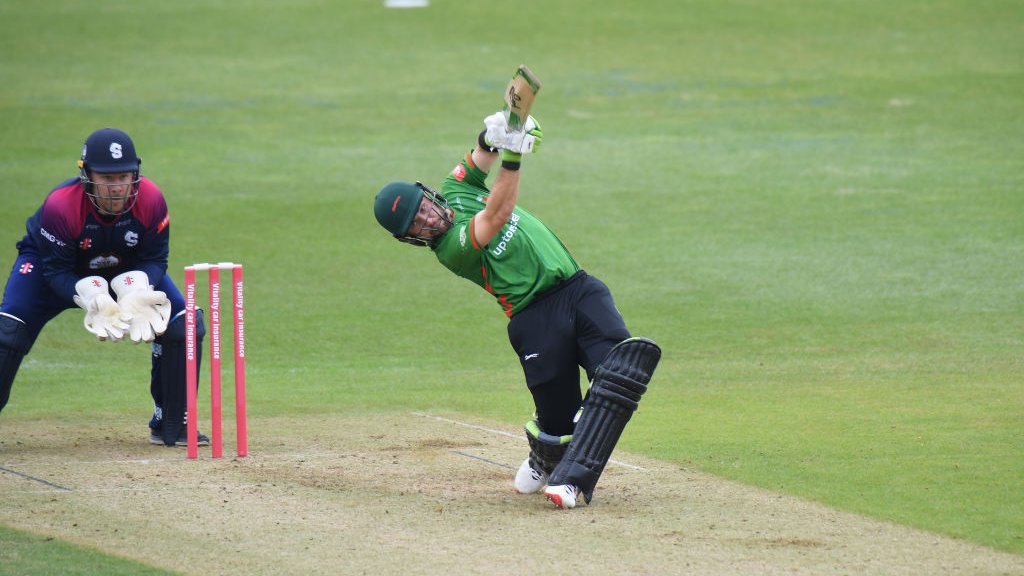10,000 miles away from Australia, Josh Inglis is making an unignorable case for T20 selection
Josh Inglis is by some distance the best-uncapped batsman in Australia, but the time has come for the selectors to start looking at the Western Australian as a genuine World T20 candidate.

“Josh Inglis is having the game of his life” tweeted the official Vitality Blast handle on Tuesday, June 15, as the Australian (or should we call him the Inglisman?) posted what, at that time, was the highest score of his T20 career. Opening the batting for Leicestershire, the wicket-keeper batsman exploded. He’d threatened to go big in each of his first two Blast games (34 off 19 and 24 off 14 respectively) but in Leeds, Inglis batted at a level he rarely had previously in his career.
Not only did he, in that game, convincingly outperform Jonny Bairstow, arguably the best T20 batter in the world, such was the outrageousness of Inglis’ knock that at one stage, Leicestershire were also on course to knocking off the 241 set by Yorkshire with several overs to spare. That eventually did not materialize as the rest of the batters fell like a pack of cards once the Australian was dismissed (for a 37-ball 82) but Inglis had sent a clear message.
Yet despite the knock being impactful enough to grab the attention of franchises across the globe, Inglis wasn’t satisfied. He woke up five days later desperately wanting to better the Yorkshire showing, and so he did. On Sunday in Northampton, Inglis blasted the first-ever T20 century of his burgeoning career, bludgeoning a helpless Northants attack that got caught in the storm. But on this occasion the pocket dynamite ensured that he took his side over the line, handing Leicestershire the first win of their 2021 Vitality Blast campaign.
You wonder if Sunday might have been one of those rare days where Inglis would have been grateful for having been ignored by the national selectors. Had he, like Dan Christian and Ben McDermott, been added to the Australian squad for the tour of the Caribbean, neither the century nor the 82 would have happened. Yet they have, and you now imagine that the dynamic batsman has given the Australian selectors no option but to throw him right into their WT20 plans.
And after all, why wouldn’t they? For many, these Vitality Blast games - which, luckily for Inglis, are being streamed live on YouTube - might have been their first exposure to Inglis, but back home in Australia in the Big Bash League, the 26-year-old has been relentlessly producing such knocks of impact for two years running.
Since the start of the 2019/20 season, only Alex Hales and Chris Lynn have scored more BBL runs than Inglis at a higher rate. But, unlike the Western Australian, both the said batters had the luxury of exclusively batting at the top of the order. Inglis, across both 2019/20 and the 2020/21 BBL seasons, batted everywhere from #1 to #5, adopting multiple roles - explosive opener, accumulator, finisher. And thus his numbers - 817 runs at an average of 31 and SR of 146 - are outrageous for what they are. All this while, the national selectors have overlooked him on the pretext of inexperience, but through his showing in the ongoing Vitality Blast, the Scorchers talisman is making an unignorable case for national selection.
Why Inglis has been overlooked by the Australian selectors
Australia’s chief selector Trevor Hohns has publicly not discussed the (non) selection of Inglis, but there are two factors that have worked against the Western Australian, the first of which is his relative inexperience. Though 26, it was only two seasons ago, after years of struggle, that the wicket-keeper batsman became a certain starter in the Perth Scorchers XI. That he took Australian cricket by storm - across all formats - after enduring his breakthrough season in 2019 is a different argument altogether, but, in the selectors’ defence, he really only has had two full seasons under his belt. And, not to mention, he had, prior to this ongoing Vitality Blast, not played franchise cricket outside Australia.
The second and arguably the biggest reason for his non-selection is that he is a wicket-keeper and (primarily) an opener. And unfortunately, Australia happen to have an endless supply for both positions. Finch, Warner, Philippe, Wade, Stoinis, Short and Carey are all in front of Inglis in the pecking order, and though he batted in the middle order for the Scorchers in BBL 10, it could be argued that the selectors were justified in not selecting him based on one good season down the order.
Why Australia need to throw Inglis into the middle-order in T20 cricket
In a recent interview with Jarrod Kimber, T20 legend Brad Hodge described No.4 as the worst position to bat in T20 cricket. Hodge claimed that batting No.4 in T20 cricket is ludicrously arduous as you not only have more responsibility on your shoulders and limited boundary options, you also have the task of tackling the spinners, which is right up there as the toughest challenge in short-form cricket. In BBL 10, Inglis batted in the dreaded #4 position in a tournament that had its fair share of spin dominance, with all of Rashid Khan, Tanveer Sangha, Adam Zampa, Peter Hatzoglou and Steve O’Keefe enduring excellent seasons.
Yet the right-hander tackled the threat of the spinners with ease, not just seeing them off with little hassle but dominating them. Against all spinners in BBL 10, Inglis averaged 44.33 and struck at 131.6, boasting a dot-ball percentage lower than 20%. In the middle-overs (7 to 15), this average shot up to 51.00, while he still managed to operate at a healthy rate of 122.8, rotating the strike efficiently and effectively.
What stood out, however, was how he fared against the best spinners in the competition. Against Rashid Khan, Adam Zampa, Tanveer Sangha and Peter Hatzoglou - statistically, the four best spinners in BBL 10 - Inglis scored 26 runs off the 16 balls he faced, being dismissed not once by any of the four bowlers.
Though being a very small sample size, this was one of the primary reasons for Ponting throwing Inglis’ name into the mix for the WT20: he is an extremely proficient player of spin bowling.
"Josh Inglis' name could be thrown into the ring as well – I really liked what I saw from him batting in the middle order in last summer's BBL. He plays spin really well and you think about where the World Cup is going to be (in India or the UAE), he could be a name that could come up (for selection),” Ponting had said in May.
But Inglis’ excellence in the middle-order extends well beyond his ability to play spin, for there are very few - if any - batsmen who can knock around the ball as efficiently as the right-hander in the middle-over phase. In BBL 10, among middle-order batters (No. 4, 5 and 6), only Glenn Maxwell scored more runs in overs 7-15 than Inglis, and no batsman had a lower dot-ball percentage in the phase than the Western Australian (21.8%).
The statistic that really pushes his case for selection, though, is how he seamlessly, as soon as the death overs beckon, shifts gears and transforms into a beast when closing the innings out. Among batsmen who faced at least 40 balls at the death (16-20) in BBL 10, no one struck at a higher rate than Inglis (222.73).
These are very relevant numbers as over the past half a decade, the Aussies have found it impossible to find middle-order batters (not named Glenn Maxwell) who they can rely upon. Stoinis, Marsh, Head, Handscomb, McDermott, Wade, Turner, Carey have all been tried and tested to no avail, and the recent failure in New Zealand encapsulated the struggle: minus Stoinis’ freak 78 in Dunedin, the middle-order averaged a hideous 14.76. Given these figures, it was a miracle that Australia went into the 5th T20I with the series level.
But how can Australia throw Inglis into the middle-order when he is now achieving success as an opener?
This is a valid point, and while Inglis racking up tons as an opener in the Blast is beneficial for his CV and development, it is less than ideal from an Australian perspective that he is doing so batting at the top of the order. But this is not something new in Australian cricket. For years now, players have been shoved into the national side at a position in which they don’t play for their franchise.
Stoinis bats at the top of the order for Melbourne Stars - and that is where he’s had all the success - yet Australia have continued to utilize him as a finisher. Carey was utilized as a finisher for the national side when he opened the batting for the Adelaide Strikers and, most recently, Mitchell Marsh was deployed at #6 and #7 in the New Zealand series despite him predominantly batting in the Top 4 for Scorchers. So, really, playing a batsman out of position won’t really be alien to Australia. If anything, Inglis has a strong case thanks to him having featured in the middle-order for the Scorchers; that he is equally good at both positions is down to his own excellence.
Time will only tell if Inglis will be on that plane to Dubai, but it will only be Australia’s loss if he isn’t.

Comments
Sign up or log in to your account to leave comments and reactions
0 Comments